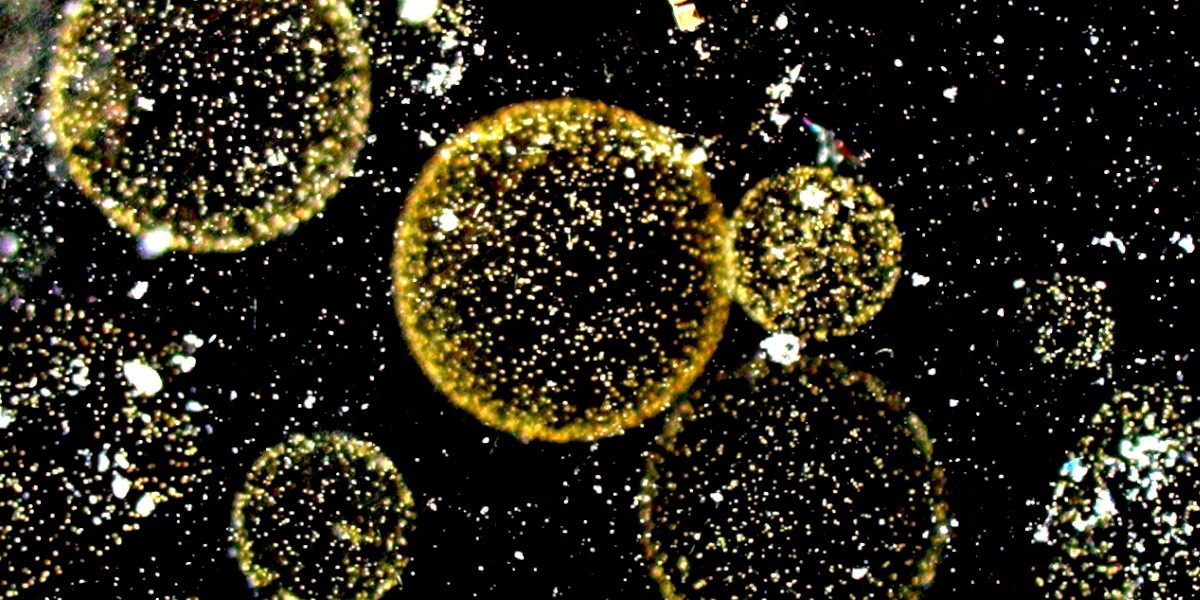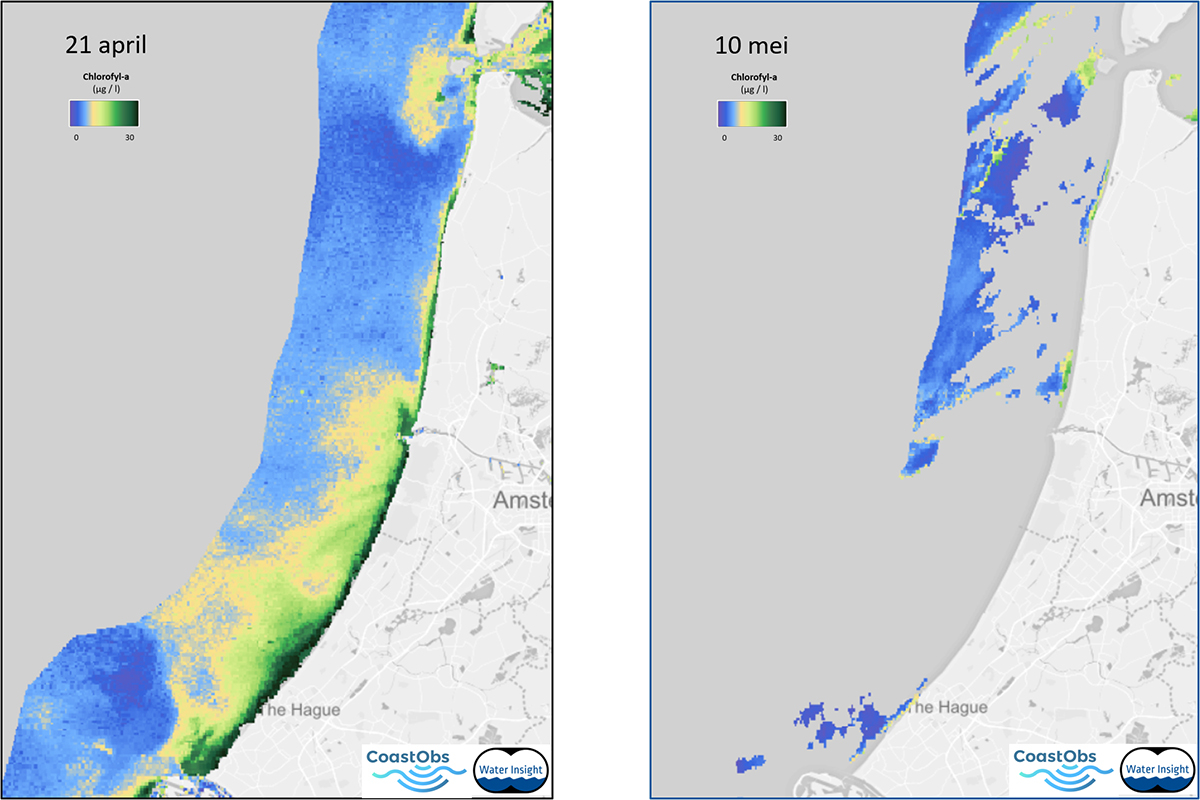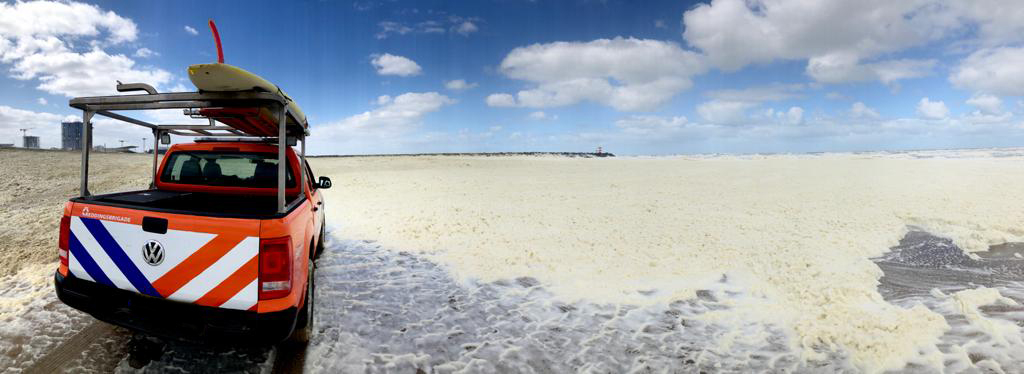Schuim in Scheveningen gevolg van veel algen en harde noordenwind

---for English scroll down ---
Reconstructie van de laatste vier dagen
Uit de reconstructie van de beschikbare data blijkt dat een samenloop van weersomstandigheden vanaf eind april heeft geleid tot de grote hoeveelheid schuim in de hoek van het Noordelijk Havenhoofd en het strand van Scheveningen. Meest waarschijnlijk is dat in de voorafgaande periode veel zon eerst zorgde voor de groei van uitzonderlijk veel schuimalgen in zee. Rond 10 mei was de bloei aan het afnemen, onder meer door verminderd licht door bewolking en meer menging. Daardoor kwamen de algenresten vrij in zee.
In hun rapport schetsen de onderzoekers het meest aannemelijke scenario op de dag van het ongeval. Op maandag 11 mei stond de noord-noordoostenwind min of meer parallel aan de kust en had aan het begin van de middag kracht 7 Beaufort. De wind dreef het gevormde schuim vervolgens naar het zuiden, waardoor het zich ophoopte tegen obstakels die dwars op het strand in zee steken, zoals het Noordelijk Havenhoofd van Scheveningen. Aan het begin van de avond draaide de wind iets meer naar het noorden en veranderde de stroming, waardoor het opgehoopte schuim zich ging verplaatsen in het gebied tussen het Noordelijk Havenhoofd en het strand van Scheveningen.
Kolonievormende algen
Algenonderzoeker Katja Philippart van het Koninklijk Nederlands Instituut voor Onderzoek der Zee (NIOZ) coördineerde dit onderzoek en licht toe hoe er begin mei zoveel algen in het zeewater aanwezig konden zijn. “Deze soort algen met de wetenschappelijke naam Phaeocystis globosa kan in zee leven in twee vormen: als solitaire cellen of in kolonies. In kolonies worden de cellen bij elkaar gehouden door een slijmachtige matrix, die hen beschermt tegen virusinfecties en vraat door zeedieren. De algencellen zijn dan niet overgeleverd aan het normale ecologische systeem van ‘eten en gegeten worden’ en de schuimalg kan daardoor snel in biomassa toenemen.”
Om kolonies te kunnen vormen, hebben algen zowel veel (zon)licht nodig als een ruime aanvoer van de voedingsstoffen stikstof en fosfaat. Begin mei waren de omstandigheden dusdanig dat de algencellen in kolonies groeiden en zo een veel grotere biomassa bereikten dan in solitaire vorm mogelijk zou zijn. Metingen in het Marsdiep suggereren dat na deze algenbloei de hoeveelheid algencellen in het zeewater dit jaar vier keer zo hoog was als tijdens de gemiddelde piek gedurende de afgelopen tien jaar.
Maar bij een tekort aan licht (minder zon, sterkere menging) valt de kolonie-matrix uiteen. Philippart: “De bewolking van zondag 10 mei triggerde waarschijnlijk het uiteenvallen van de uitzonderlijke hoeveelheid koloniecellen tot een ongekende hoeveelheid losse, solitaire cellen, waarbij de suikerachtige overblijfselen van de matrix in zee terechtkwamen. Door infecties met virussen sprongen solitaire algencellen al snel open en kwamen ook de eiwitten uit de cellen vrij in het water.”
Onderzoekers adviseren meer voorlichting
Ondanks het feit dat de onderzoekers op basis van hun meetgegevens het meest waarschijnlijke scenario voor het ontstaan van de uitzonderlijke hoeveelheid algenschuim op 11 mei hebben kunnen achterhalen, zal het lastig zijn om een betrouwbaar geautomatiseerd waarschuwingssysteem voor watersporters op te zetten, aldus Philippart. “Dan moet je niet alleen de hoeveelheid schuimalg en het schuim nauwkeurig blijven monitoren, je moet ook de actuele windsterkte en -richting real time, tot in groot detail én zeer lokaal kunnen voorspellen. Daarom pleiten wij ervoor om op korte termijn strandwachten, watersportscholen en watersporters meer voorlichting te geven, zodat ze in staat zijn om eventuele ophoping van zeeschuim zelf goed in te schatten.”

Foam in Scheveningen due to a large plankton bloom and strong northerly winds
The metres high seafoam during the fatal accident involving five surfers on 11 May in Scheveningen most probably arose due to an exceptional combination of many algal remains and, for this time of the year, an unusually strong north-northeasterly wind. That is the conclusion of researchers from various organisations in the report about the cause of the foam formation. The authors limited themselves to conclusions that currently seem the most reasonable, and the available data will be further analysed. At present, the scientists advise providing information and training to lifeguards and people who practise water sports, because the development of a sufficiently automated warning system will take more time.
Reconstruction of the last four days
The reconstruction from the available data reveals that a conjunction of weather conditions from the end of April led to the large quantity of foam in the corner of the Northern Harbour Head on the beach of Scheveningen. It is most likely that in the preceding period, a lot of sun first led to the growth of an exceptionally large quantity of seafoam algae in the sea. Around 10 May, the bloom was decreasing, partly due to reduced light as a result of cloud cover and more wind-driven mixing of the seawater. As a result of this, the algal remains were released into the sea.
In their report, the scientists describe the most likely scenario on the day of the accident. On Monday 11 May, the north-northeasterly wind blew more or less parallel to the coast and at the start of the afternoon was a force 7 wind on the Beaufort Scale. The wind subsequently drove the foam that had been formed towards the south where it accumulated against obstacles that run across the beach straight into the sea, such as the Northern Harbour Head of Scheveningen. At the start of the evening, the wind turned slightly more to the north and the currents changed, as a result of which the accumulated foam started to move in the area between the Northern Harbour Head and the beach of Scheveningen.
Colony-forming algae
Plankton scientist Katja Philippart from the Royal Netherlands Institute for Sea Research (NIOZ) coordinated the research and explains how there could be so many algae present in the seawater in early May. ‘The scientific name of this algal species is Phaeocystis globosa, and in the sea it occurs in two forms: solitary cells or in colonies. In colonies, the cells are held together by a mucous-like matrix, which protects the cells against viral infections and from being consumed by sea animals. The algal cells are then not subject to the normal ecological system of “eat or be eaten” and the seafoam algae can therefore rapidly increase their biomass.’
To form colonies, algae need a lot of solar irradiance (sunlight) and a high availability of nutrients such as nitrogen and phosphate. In early May, the conditions were such that the algal cells grew in colonies and so a much greater biomass was achieved than would have been possible in the case of the solitary form. Measurements in the Marsdiep suggest that, after this plankton bloom, the quantity of algal cells in the seawater was four times as high as during the average peak over the past ten years.
However, if there is a lack of light (less sun, stronger mixing) then the colony matrix falls apart. Philippart: ‘The cloudy weather of Sunday 10 May could have triggered the disintegration of the exceptional quantity of colony cells into an unparalleled quantity of individual solitary cells, as a result of which the sugar-like remains of the matrix ended up in the sea. Due to viral infections, the solitary algal cells quickly burst open and the proteins were also released from the cells into the water.’
Researchers advise more awareness
Although the scientists on the basis of the measurement data have been able to determine the most likely scenario for the development of the exceptional quantity of algal foam on 11 May, it will be difficult to set up an automatic warning system for people who practise water sports, states Philippart. ‘Then you must not only be able to keep on accurately monitoring the quantity of seafoam algae and foam, but you must also be able to predict the current wind strength and direction in real-time very locally and in considerable detail. Therefore, in the short term, we are calling for lifeguards, water sports schools and people who practise water sports to be given more information so that they are capable of making a good estimate of the possible accumulation of seafoam.’

De volgende onderzoekers werkten mee aan het rapport/The following researchers contributed to the report:
Katja Philippart (NIOZ en UU), Anouk Blauw (Deltares), Henk Bolhuis (NIOZ), Karen Brandenburg (NIOO en UU), Corina Brussaard (NIOZ en UvA), Theo Gerkema (NIOZ), Peter Herman (Deltares en TUD), Annelies Hommersom (Water Insight), Pascalle Jacobs (NIOZ), Marnix Laanen (Water Insight), Maria van Leeuwe (RUG), Anneke van den Oever (BuWa), Steef Peters (Water Insight), Marc Philippart (Rijkswaterstaat), Jaime Pitarch (CNR), Theo Prins (Deltares), Kevin Ruddick (KBIN), Lazaros Spaias (Water Insight), Dedmer van de Waal (NIOO), Dimitry Van der Zande (KBIN), Alain Zuur (Highland Statistics).